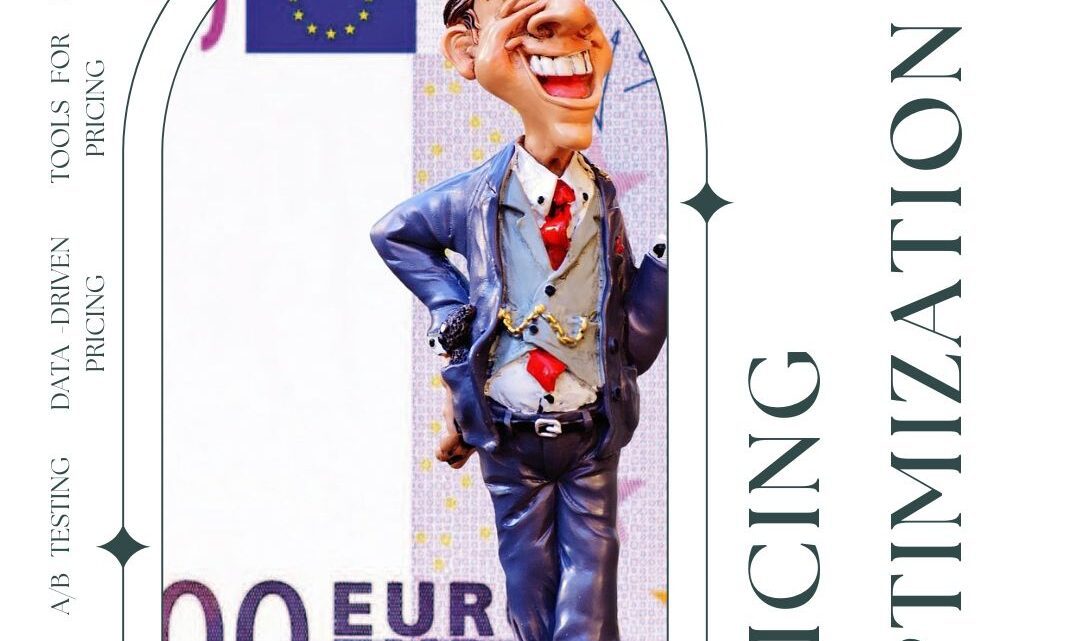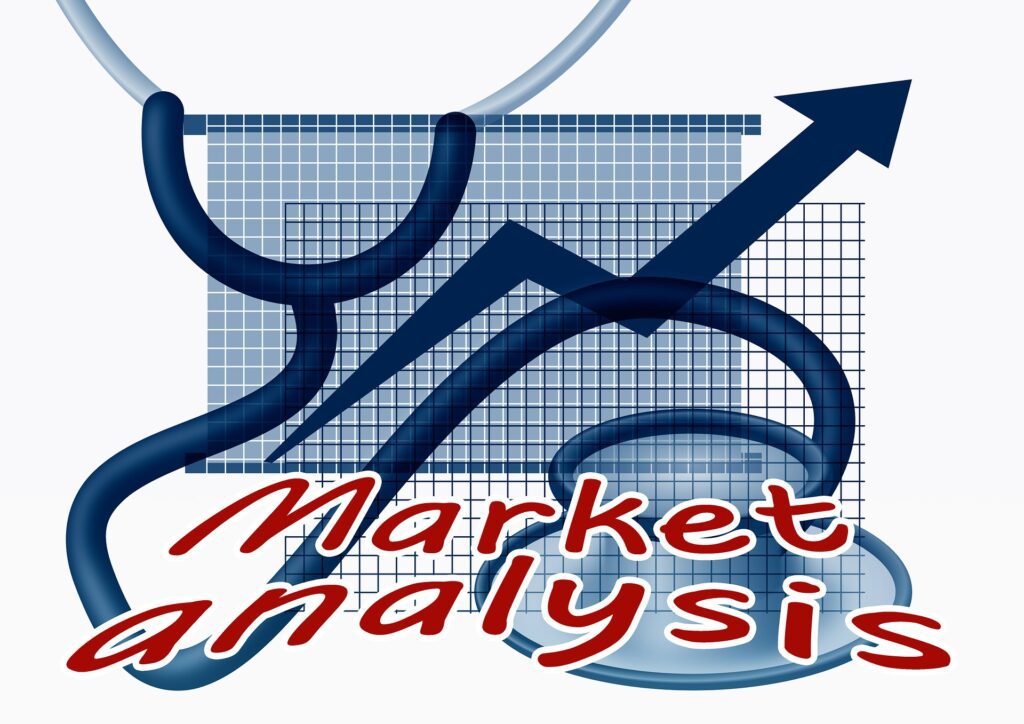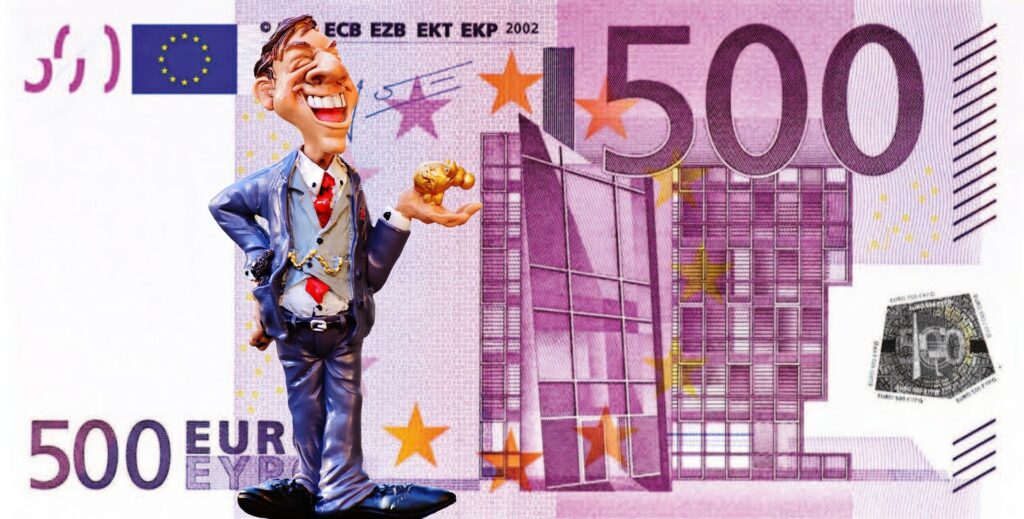Pricing Optimization – This is How to Optimize Prices
May 27, 2023
Pricing Optimization – This is How to Optimize Prices. Pricing Optimization: Techniques and Tools for Maximizing Profitability
Introduction : Pricing Optimization
Welcome to our blog on pricing optimization, where we delve into the various techniques and tools businesses can employ to optimize their pricing strategies. In today’s competitive marketplace, setting the right prices is crucial for maximizing profitability and staying ahead of the competition. We will explore key concepts such as price elasticity analysis, A/B testing, and data-driven pricing decisions, providing insights into how these strategies can be effectively implemented to drive business success.

Pricing Optimization – Understanding Price Elasticity Analysis
Price elasticity analysis is a fundamental concept in pricing optimization that allows businesses to assess how sensitive customer demand is to changes in price. It provides valuable insights into the relationship between price and demand, enabling companies to make informed decisions about pricing strategies. Let’s delve deeper into the importance of price elasticity, its calculation methods, and how businesses can leverage this information to optimize their pricing decisions.
Importance of Price Elasticity
Price elasticity is a crucial metric because it determines how customers react to changes in price. By understanding price elasticity, businesses can gauge the potential impact of price changes on their revenue and profitability. Products or services with higher price elasticity are more responsive to price changes, meaning that even small adjustments in price can significantly impact demand and revenue. Conversely, products with low price elasticity are less affected by price changes, allowing businesses more flexibility in their pricing strategies.
Calculation Methods
There are various methods to calculate price elasticity, with the most common being the percentage change method and the point elasticity method.
- Percentage Change Method: This method measures the percentage change in quantity demanded in response to a given percentage change in price. The formula for price elasticity using the percentage change method is:
Price Elasticity = (Percentage Change in Quantity Demanded) / (Percentage Change in Price)
- Point Elasticity Method: This method determines price elasticity at a specific point on the demand curve. It calculates the ratio of the percentage change in quantity demanded to the percentage change in price. The formula for price elasticity using the point elasticity method is:
Price Elasticity = (ΔQ / Q) / (ΔP / P)
Point Elasticity Method Price Elasticity = (ΔQ / Q) / (ΔP / P)
The formula Price Elasticity = (ΔQ / Q) / (ΔP / P) represents the calculation of price elasticity using the point elasticity method. Let’s break down the components of this formula and understand their meaning:
ΔQ: This represents the change in quantity demanded of a product or service. It refers to the difference between the initial quantity demanded (Q1) and the new quantity demanded (Q2) resulting from a change in price.
Q: This represents the average quantity demanded, which is the average of the initial quantity demanded (Q1) and the new quantity demanded (Q2).
ΔP: This represents the change in price. It refers to the difference between the initial price (P1) and the new price (P2) that caused the change in quantity demanded.
P: This represents the average price, which is the average of the initial price (P1) and the new price (P2).
By calculating the ratio of the percentage change in quantity demanded to the percentage change in price, this formula determines the price elasticity of demand at a specific point on the demand curve.
If the result of the formula is greater than 1, it indicates elastic demand. This means that a percentage change in price will result in a greater percentage change in quantity demanded. In other words, customers are highly responsive to price changes, and a decrease in price will lead to a significant increase in demand and revenue.
If the result of the formula is less than 1, it indicates inelastic demand. This means that a percentage change in price will result in a smaller percentage change in quantity demanded. In this case, customers are less sensitive to price changes, and a price increase may not significantly impact demand or revenue.
If the result of the formula is exactly 1, it indicates unitary elasticity. This means that a percentage change in price will result in an equal percentage change in quantity demanded. Unitary elasticity suggests that revenue remains constant regardless of price changes.
By applying this formula to different price points along the demand curve, businesses can understand the price elasticity at various levels of pricing and make informed decisions about their pricing strategies.
Leveraging Price Elasticity Analysis for Pricing Decisions: Price elasticity analysis provides businesses with valuable insights that can guide their pricing decisions. Here are a few ways businesses can leverage price elasticity analysis:
Optimal Pricing
By understanding the price elasticity of their products or services, businesses can identify the price points that maximize revenue. For products with elastic demand, lowering prices may lead to increased demand and overall revenue. Conversely, for products with inelastic demand, businesses may consider higher prices to maximize profitability.
Pricing Strategies
Price elasticity analysis can help determine the appropriate pricing strategy for different products or customer segments. For example, businesses can implement price discrimination strategies by setting different prices for different market segments based on their respective price elasticities.
Promotion Planning
Price elasticity analysis can also aid in promotional planning. By considering the price elasticity of a product, businesses can assess the potential impact of discounts, promotions, or bundling offers on customer demand. This information can help optimize promotional activities and maximize the effectiveness of marketing campaigns.
New Product Pricing
Price elasticity analysis is particularly valuable when introducing new products to the market. By analyzing the price elasticity of similar existing products or conducting market research, businesses can estimate the price sensitivity of potential customers and set competitive prices for new offerings.
Conclusion – Pricing Optimization Price elasticity analysis
A/B testing is a powerful technique used in marketing and pricing optimization to evaluate different pricing strategies and identify the most effective approach. By comparing two or more versions of a product’s pricing, businesses can gather valuable data on customer behavior, preferences, and the impact of pricing on conversions and revenue. In this section, we will delve into the process of conducting A/B tests effectively, covering the key steps of defining test parameters, setting up experiments, collecting data, analyzing results, and showcasing real-world examples of successful A/B tests and the insights they generated.
Defining Test Parameters
Before initiating an A/B test, it is crucial to define the parameters and objectives clearly. This includes determining what aspect of pricing will be tested, such as the price point, discount percentage, or pricing structure. Additionally, identifying specific metrics to measure, such as conversion rate, revenue, or profitability, helps ensure the test’s effectiveness. Defining the sample size, test duration, and statistical significance threshold are also vital considerations to ensure accurate results.
Setting up Experiments
Once the test parameters are defined, businesses need to set up the experiments effectively. This involves creating multiple versions of pricing (e.g., A and B variations) that differ in the parameter being tested. It is important to ensure that each version is randomly assigned to a segment of the target audience to eliminate bias. This can be achieved through methods such as randomized website or email segmentation, or through platform-specific tools that facilitate A/B testing.
Collecting Data
During the A/B test, businesses need to collect relevant data to assess the performance of each pricing variation. This includes tracking metrics such as conversion rates, revenue, customer behavior, and other key performance indicators. Accurate data collection is essential, and it can be achieved through web analytics tools, CRM systems, or custom-built tracking mechanisms. It is crucial to monitor and record the data consistently throughout the test duration to ensure reliability and accuracy.
Analyzing Results
Once the A/B test concludes, it is time to analyze the collected data to draw meaningful insights. Statistical analysis plays a crucial role in determining the significance of the results. Techniques such as hypothesis testing, confidence intervals, and statistical significance testing help assess the performance of each pricing variation. Analyzing the results should involve comparing the key metrics between the A and B variations to identify which pricing strategy performed better in terms of the defined objectives.
Real-World Examples
For instance, an e-commerce company might have tested different discount percentages to determine the optimal level that maximizes revenue without excessively eroding profitability. Another example could involve testing different pricing tiers or subscription models to identify the most appealing option to customers. These examples demonstrate the tangible benefits of A/B testing and the insights that can be gained from it.
Conclusion – Pricing Optimization A/B testing
A/B testing is a powerful technique for pricing optimization, enabling businesses to make data-driven decisions about their pricing strategies. By effectively defining test parameters, setting up experiments, collecting accurate data, and analyzing results, companies can uncover valuable insights into customer behavior, preferences, and the impact of pricing on conversions and revenue. Real-world examples further highlight the efficacy of A/B testing in driving business success. By harnessing the power of A/B testing, businesses can optimize their pricing strategies and achieve better results in a dynamic and competitive marketplace.

Pricing Optimization – The Role of Data-Driven Pricing Decisions
Data-driven pricing decisions have become increasingly crucial in today’s business landscape. By leveraging comprehensive data analysis, businesses can make informed pricing choices that align with market dynamics, customer preferences, and their own strategic goals. In this section, we will delve into the process of collecting and analyzing data for pricing decisions, highlighting factors such as customer behavior, market trends, competitor pricing, and economic indicators. We will discuss the importance of data-driven pricing models, integrating data analysis tools into pricing strategies, and the potential benefits of adopting a data-driven approach.
Collecting and Analyzing Data
To make data-driven pricing decisions, businesses must gather relevant data from various sources and analyze it effectively. This involves collecting data on customer behavior, such as purchase history, browsing patterns, and demographic information. Market trends, including industry reports, market research, and consumer surveys, provide insights into broader market dynamics. Analyzing competitor pricing data helps companies understand their competitive position and make strategic pricing adjustments. Additionally, economic indicators, such as inflation rates, GDP growth, and industry-specific factors, can influence pricing decisions. By combining and analyzing these data points, businesses can gain a comprehensive understanding of the market landscape and customer preferences.
Importance of Data-Driven Pricing Models
Data-driven pricing models enable businesses to go beyond intuition and make decisions based on empirical evidence. These models use statistical analysis, machine learning algorithms, and predictive modeling techniques to uncover patterns, correlations, and price optimization opportunities within the data. By leveraging these models, companies can identify price points that maximize revenue, predict customer response to pricing changes, and identify pricing strategies that align with business objectives. Data-driven pricing models allow businesses to adapt pricing strategies based on real-time market dynamics, customer behavior, and performance metrics, leading to improved profitability and a competitive edge.
Integrating Data Analysis Tools into Pricing Strategies
Data analysis tools play a vital role in processing and interpreting large volumes of data for pricing optimization. These tools range from basic spreadsheet applications to advanced analytics platforms. They facilitate data aggregation, visualization, and statistical analysis, enabling businesses to derive meaningful insights from complex datasets. Data analysis tools can also automate data collection processes, integrate with other business systems, and generate reports and visualizations that aid in decision-making. Integrating these tools into pricing strategies allows businesses to streamline data analysis, increase efficiency, and respond to market changes more effectively.
Benefits of Adopting a Data-Driven Approach
Adopting a data-driven approach to pricing decisions offers several benefits for businesses:
- Improved Pricing Accuracy: Data-driven pricing models help businesses set prices that are aligned with market dynamics and customer preferences, resulting in improved accuracy and relevance.
- Increased Profitability: By leveraging data analysis, businesses can identify pricing strategies that optimize revenue and profitability, minimizing the risk of underpricing or overpricing.
- Enhanced Competitive Positioning: Analyzing competitor pricing data enables businesses to understand the competitive landscape and adjust their pricing strategies accordingly, ensuring a competitive advantage.
- Agility and Responsiveness: Data-driven pricing models allow businesses to adapt quickly to market changes, customer behavior, and emerging trends, enabling them to stay ahead of the competition.
- Better Customer Insights: Data analysis provides valuable insights into customer behavior, preferences, and price sensitivity. This understanding allows businesses to tailor pricing strategies to specific customer segments, enhance customer satisfaction, and improve overall customer experience.
Conclusion – Pricing Optimization Data-driven pricing decisions
Data-driven pricing decisions are essential for businesses to thrive in a competitive market. By collecting and analyzing relevant data on customer behavior, market trends, competitor pricing, and economic indicators, companies can make informed pricing choices that drive profitability and align with their strategic goals. Integrating data analysis tools into pricing strategies empowers businesses to leverage advanced analytics and statistical modeling to uncover pricing optimization opportunities. By adopting a data-driven approach, businesses can enhance pricing accuracy, increase profitability, improve competitive positioning, and gain valuable customer insights, ultimately leading to sustainable growth and success.
Pricing Optimization – Tools for Pricing Optimization
In the realm of pricing optimization, there are numerous tools and software solutions available to assist businesses in their efforts to analyze, optimize, and monitor prices. These tools offer a range of features and functionalities that can greatly enhance pricing strategies. In this section, we will showcase popular pricing tools, highlighting their key benefits and functionalities to enable readers to make informed decisions about which tools best suit their specific pricing requirements.
Pricing Analytics Tools
Pricing analytics tools help businesses analyze pricing data, identify patterns, and uncover insights that can drive pricing optimization. These tools often utilize advanced statistical analysis, machine learning algorithms, and predictive modeling techniques to identify optimal pricing strategies. They can provide valuable information on price elasticity, demand forecasting, competitor analysis, and customer segmentation. Some notable pricing analytics tools include PriceBeam, Zilliant, and PROS.
Dynamic Pricing Software
Dynamic pricing software allows businesses to adjust prices in real-time based on factors such as demand, competitor pricing, inventory levels, and customer behavior. These tools use algorithms to automatically set prices that maximize revenue and profitability. Dynamic pricing software is particularly beneficial for industries with rapidly changing market conditions, such as e-commerce, travel, and hospitality. Examples of dynamic pricing software include Omnia, Prisync, and Incompetitor.
Price Optimization Solutions
Price optimization solutions offer comprehensive platforms for managing and optimizing prices across various products, channels, and customer segments. These tools often integrate pricing analytics, competitor analysis, and demand forecasting capabilities to recommend optimal prices. Price optimization solutions provide businesses with a centralized platform to set and manage prices, simulate pricing scenarios, and measure the impact of pricing changes on revenue and profitability. Notable price optimization solutions include Vendavo, PROS, and Perfect Price.
Competitor Price Monitoring Tools
Competitor price monitoring tools help businesses keep track of competitor pricing strategies and trends. These tools automate the process of collecting and analyzing competitor pricing data, allowing businesses to stay informed about the market landscape and make competitive pricing decisions. Competitor price monitoring tools provide valuable insights into competitor price changes, promotions, and pricing positioning. Examples of competitor price monitoring tools include Price2Spy, Prisync, and TrackStreet.
Sales and Revenue Management Platforms
Sales and revenue management platforms provide businesses with a comprehensive suite of tools to optimize pricing, revenue, and sales strategies. These platforms often combine pricing optimization, revenue forecasting, sales analytics, and CRM capabilities to enable businesses to align pricing decisions with sales goals and overall revenue targets. Sales and revenue management platforms offer end-to-end solutions for pricing optimization and revenue growth. Notable platforms in this category include Zilliant, PROS, and Model N.
Conclusion – Tools for Pricing Optimization
The availability of a wide range of tools and software solutions for pricing optimization empowers businesses to make informed decisions and maximize their revenue and profitability. Pricing analytics tools, dynamic pricing software, price optimization solutions, competitor price monitoring tools, and sales and revenue management platforms all play a crucial role in helping businesses analyze, optimize, and monitor their pricing strategies. By leveraging these tools, businesses can gain a competitive edge, align prices with market dynamics, and make data-driven pricing decisions to achieve their pricing goals. When selecting pricing tools, it’s important to assess specific needs, consider budget constraints, and choose tools that align with the organization’s pricing objectives.
Pricing Optimization – Case Studies: Real-Life Examples of Successful Pricing Optimization
To showcase the impact and effectiveness of pricing optimization techniques and tools, let’s explore a selection of real-life case studies from diverse industries. These examples highlight how businesses achieved notable improvements in profitability and market share by implementing pricing optimization strategies. By examining these case studies, readers can gain practical insights and learn from the successes of others.
Case Study: Company X
E-commerce Industry Company X, an e-commerce retailer, wanted to optimize its pricing strategy to increase sales and profitability. By leveraging dynamic pricing software, they implemented a real-time pricing system that adjusted prices based on factors such as competitor pricing, customer demand, and inventory levels. Through this approach, Company X achieved a 20% increase in sales volume and a 15% boost in profit margin. The dynamic pricing software allowed them to respond quickly to market changes, optimize prices for each product, and effectively compete in a highly dynamic e-commerce landscape.
Case Study: Company Y
Travel Industry Company Y, a travel agency, aimed to improve its pricing strategy to maximize revenue from hotel bookings. They implemented a price optimization solution that integrated competitor analysis, demand forecasting, and revenue management capabilities. By analyzing market trends, competitor pricing, and customer preferences, Company Y optimized its hotel pricing dynamically. As a result, they experienced a 12% increase in average revenue per booking and a 10% rise in overall booking volume. The price optimization solution allowed them to capture demand effectively and adjust prices to reflect market conditions.
Case Study: Company Z
Manufacturing Industry Company Z, a manufacturer of consumer goods, sought to enhance its pricing strategy to remain competitive and increase market share. They adopted a data-driven pricing approach, utilizing pricing analytics tools to analyze customer behavior, price elasticity, and market trends. By aligning their prices with customer preferences and optimizing price points, Company Z achieved a 7% increase in sales revenue and gained a 5% increase in market share within a year. The pricing analytics tools provided valuable insights into customer behavior and helped them identify optimal price ranges for different customer segments.
Case Study: Company W
Software Industry Company W, a software provider, aimed to optimize its pricing model to capture more customers and increase profitability. They employed a combination of A/B testing and data analysis to evaluate different pricing structures and tiers. Through A/B testing, they identified an optimal pricing structure that balanced customer value and revenue generation. By implementing this pricing structure, Company W experienced a 30% increase in conversion rates and a 20% increase in monthly recurring revenue. The data-driven approach enabled them to refine their pricing model based on customer preferences and maximize their revenue potential.
Conclusion- Pricing Optimization Case Studies
These real-life case studies demonstrate the significant impact of pricing optimization strategies and tools across various industries. Through dynamic pricing software, price optimization solutions, data-driven pricing approaches, and A/B testing, businesses achieved remarkable improvements in profitability, sales volume, revenue, and market share. By learning from these examples, readers can gain insights into successful pricing optimization techniques and apply them to their own businesses. Implementing pricing optimization strategies tailored to specific industries and leveraging appropriate tools can help businesses thrive in competitive markets and drive sustainable growth.
Pricing Optimization – Conclusion
Pricing optimization is a multifaceted and ever-evolving process that demands businesses to continuously adapt and refine their strategies. By incorporating techniques such as price elasticity analysis, A/B testing, and data-driven pricing decisions, coupled with the utilization of appropriate tools, companies can make informed pricing choices, maximize profitability, and gain a competitive edge in the market.
Price elasticity analysis allows businesses to understand how changes in price impact customer demand, enabling them to make strategic pricing adjustments that align with revenue goals. A/B testing provides a systematic approach to compare different pricing strategies, allowing companies to identify the most effective pricing approach for their products or services. Data-driven pricing decisions, backed by comprehensive data analysis, help businesses make informed choices by considering customer behavior, market trends, competitor pricing, and economic indicators.
By delving into these topics in detail, we aim to empower you with the knowledge and understanding necessary to optimize your pricing strategies and drive business growth. Through the exploration of pricing elasticity analysis, A/B testing techniques, and the integration of data-driven pricing decisions, you will gain valuable insights into how these practices can be implemented in your own business. Armed with this knowledge, you will be better equipped to make informed pricing decisions that maximize revenue, improve profitability, and enhance your competitive position.
As the pricing landscape continues to evolve, it is essential to stay informed and up-to-date with the latest techniques and tools for pricing optimization. By continually refining your pricing strategies and leveraging the power of data and experimentation, you can adapt to changing market dynamics, customer preferences, and competitive pressures. Stay tuned as we explore each of these topics in-depth, providing you with practical guidance and real-world examples to help you navigate the intricacies of pricing optimization successfully.
Remember, pricing optimization is a continuous journey, and the key to success lies in a combination of sound strategies, data-driven insights, and the willingness to adapt and innovate. By embracing the techniques and tools discussed in this blog, you can position your business for long-term success and growth in today’s competitive marketplace.
Competitive Pricing Analysis – Strategies to Gain a Competitive Edge
Pricing Psychology – All what You Need To Know
Pricing Models – The popular ones You Need To Know
Crypto Prices & Live Exchange Rates



